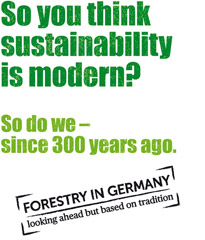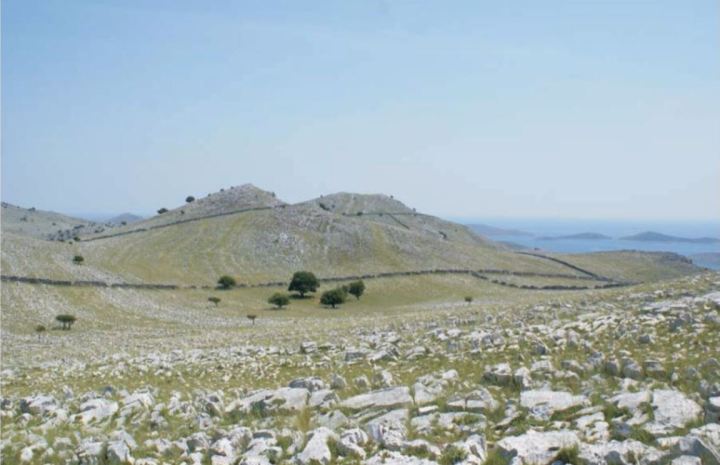The German term “Nachhaltigkeit” (sustainability) was first used in forest management by Hans Carl von Carlowitz, but the concept is still older.
This post was inspired by a facebook conversation some time ago on renewable and non-renewable resources:
A: Those who have an interest in continuing to make and sell products have a profit motive to replenish and renew their supply, e.g., timber companies plant more trees than anyone else.
Me: Timber is renewable. In fact, the term “sustainability” was coined by von Carlowitz in the context of forestry.
B: Is it true that a man named von Carlowitz was first to use the word “sustainability”? Sustainable: of, relating to, or being a method of harvesting or using a resource so that the resource is not depleted or permanently damaged. The concept of sustainability did not originate with forestry, nor does it end there. Sustainable techniques are applied to all natural resources, as well as behaviors…..
It did originate in forestry. Here is the story.
Erzgebirge (Saxony, Germany), early 18th century
 Due to the increasing demands of the developing mining industry and the agglomeration of small cities, the original large and dense forests in this region in Saxony had disappeared. Trees had been clear-cut over the course of generations, old-growth forest had disappeared, and no effort had been made to regenerate the forests. The extensive grazing of cattle, pigs and goats, as well as subsistence agriculture, impeded forest recovery. The local mining chief, Hans Carl von Carlowitz had one major problem: the silver mines were far from depleted, but the mining industry needed wood (and a whole lot of it), and wood was becoming unavailable and unaffordable; it was in fact becoming so scarce that small industries were even at the brink of bankruptcy. As he would later state: In a few years, more trees will have been felled in Europe than have grown in several centuries (“Binnen wenig Jahren ist in Europa mehr Holtz abgetrieben worden, als in etzlichen seculis erwachsen”).
Due to the increasing demands of the developing mining industry and the agglomeration of small cities, the original large and dense forests in this region in Saxony had disappeared. Trees had been clear-cut over the course of generations, old-growth forest had disappeared, and no effort had been made to regenerate the forests. The extensive grazing of cattle, pigs and goats, as well as subsistence agriculture, impeded forest recovery. The local mining chief, Hans Carl von Carlowitz had one major problem: the silver mines were far from depleted, but the mining industry needed wood (and a whole lot of it), and wood was becoming unavailable and unaffordable; it was in fact becoming so scarce that small industries were even at the brink of bankruptcy. As he would later state: In a few years, more trees will have been felled in Europe than have grown in several centuries (“Binnen wenig Jahren ist in Europa mehr Holtz abgetrieben worden, als in etzlichen seculis erwachsen”).
Von Carlowitz studied the problem thoroughly. With his wide knowledge of the literature, he had the ability to compare the forest situation in Saxony with that in other European countries. He was aware of innovative efforts undertaken elsewhere to develop new approaches and a more productive use of land in both agriculture and forestry. During his stay in France he became familiar with Colbert’s legal reforms, which led to the Forestry Code of 1669. He quoted the new code extensively in his book, saying that most if his ideas were already contained in it. He visited the forest of Montello in the Alto Adige, which was managed by the city of Venice for the supply of hardwoods for the Venetian fleet. And he likely knew John Evelyn’s “Sylva“.
In 1713, one year prior to his death, von Carlowitz published his book Sylvicultura Oeconomica in which coined the term Nachhaltigkeit (“sustainability”) by referring to the concept of nachhaltige Nutzung (“sustained use”). He provided a definition for what became, in following decades, the basic concept of forest management:
“The greatest art, science, diligence and institution of these countries will rely on the manner in which such conservation and growing of wood is to be undertaken in order to have a continuing, stable and sustained use, as this is an indispensable cause, without which the country as we know it cannot survive.”
The flourishing economy has to serve the “common good“. Not only the subjects have the right to receive “plenty of food and livelihood”. The same right should also be reserved “for future generations. He complains that people are short-sighted and only looking for their current profit instead of using “benevolent nature” carefully. *
As a pious Lutheran, nature was not only a resource that had to be managed: it was primary a masterpiece that reflected God’s almighty power and wisdom. He therefore suggested that man has to “study in this great Book of Nature” to find out how “to play with nature” and then to act in accordance with her and not against her.** And Carlowitz learned the play (or the formulae) of nature, specifically of trees and forests: he gave specific indications which trees grow fast or slow, the optimal time to wait before cutting them down, the optimal space between them when planting them for growing them to maturity etc. In addition, he gave indications how to build houses with better thermal insulation, and proposed to use a “surrogate” like peat as combustible heating material for the mining industry.
Von Carlowitz’s concept of sustainability was further developed by others. Wilhelm Gottfried Moser, an administrator and forester, referred to the intragenerational and intergenerational elements of Nachhaltigkeit in 1757:
“A sustainable economy is as reasonable, just and wise as it is certain that man must not live only for himself, but also for others and for posterity”.
A series of programs were initiated and soon, the problem of deforestation could be banned. The thoroughly calculated and managed forests (often monocultures) are now slowly being replaced by more biodiverse, nature-near forests.

And, as published recently (Richard Fuchs, Models of Geo-Information Science and Remote Sensing: HILDA), Europe’s forests are currently even growing. This animated graphic shows the timeframe between 1900 and 2010.
Europe’s forests during the Middle Ages
Forest overuse was already a local problem in earlier times: Many early measures were taken to help conserve forests in Europe. In Germany, for example, common law as early as 1330 mentioned that woodcutting should be moderate and carried out without causing devastation. Specific rules were adopted by villages, communal land associations, monasteries and towns. Forests near settlements were reserved for the use of local people and divided into coupes (rotation areas) to be harvested annually, after which such areas were to be protected from grazing until tree regeneration was assured.
And in the French “Ordonnance de Brunoy“ (1346), the first regulation on forest use, we not only find the concept of sustainable forest management, but even the expression: “sustain in good condition”:
“The owners of waterways and forests will make enquiries about and visit all forests and woods and will conduct sales that will allow the aforementioned forests to perpetually sustain themselves in good condition”.
From early on, people already realized that forests were a common good to be protected by appropriate regulations. It did not work out everywhere, though: in Slovenia, Croatia and Bosnia are the so-called Karst-region (“karst” is derived from a Slavic word that means barren, stony ground), regions of bare limestone with sinkholes and caves. These regions were once forested but deforestation began in pre-historic time with culmination points in history such as when the Greeks and Illyrians needed timber for building their fleets, and later in the Middle Ages when Venice was built on piles of wood, when French occupiers used the wood to construct a naval base in France and when Austrian army officers claimed it for their needs. Once barren, trees did not re-appear naturally: the soil was barren and dry, and the “bora”, a warm and story wind from the inner land to the Adriatic Sea, did its share to carry the soil away.

Coastal part of Dinaric karst experienced severe deforestation (Photo A. Mihevc)
Partial reforestation efforts in the 19th/20th centuries needed full dedication, manpower and investment – but they were possible.

Tropical Rainforest in Colombia
We are confronted with an even more difficult situation in the tropical rain forests today. Deforestation is an easy and quick hit for momentary financial gain, but reforestation is nearly impossible: it is not the soil that nourishes the forest, it is the mesh of living and dead plants and animals above the ground that provides the substrate for the trees to grow high above in the sky. Hence, the only possible way for sustainable management is conservation.
Conclusion
Economic development, social development and environmental protection are the 3 pillars of sustainability, a concept we use today in all aspect of human development and which has reached global importance in a globalized world. We find all three components already incorporated in the description of sustainability in forest management in the early 18th century.
_________________________________
* Die Hebung von “Handel und Wandel”, die “florirenden Commercia” müssten “zum Besten des gemeinen Wesens” dienen. Die “armen Untertanen” hätten ein Recht auf “sattsam Nahrung und Unterhalt”. Aber dasselbe Recht stehe “der lieben Posterität” zu. In klaren Umrissen wird schon das Dreieck der Nachhaltigkeit sichtbar: Die Ökonomie hat der “Wohlfahrt” des Gemeinwesens zu dienen. Sie ist zu einem schonenden Umgang mit der “gütigen Natur” verpflichtet und an die Verantwortung für künftige Generationen gebunden. (aus [1])
** Der Mensch müsse in dem “grossen Welt-Buche der Natur studiren”. Er müsse erforschen, wie “die Natur spielet”, und dann “mit ihr agiren” und nicht wider sie. (aus [1])
______________________________________
Literature used:
[1] Ulrich Grober, Der Erfinder der Nachhaltigkeit, Zeit, 1999
[2] Wikipedia: Sylva, or A Discourse of Forest-Trees and the Propagation of Timber in His Majesty’s Dominions
[3] F. Schmithüsen, Three hundred years of applied sustainability in forestry, Unasylva 240, Vol. 64, 2013/1
[4] Andrej Kranjc, Dinaric Karst – An Example of Deforestation and Desertification of Limestone Terrain, 2012. Deforestation Around the World, Dr. Paulo Moutinho (Ed.), ISBN: 978-953-51-0417-9, InTech
[5] Andrej Mihevc, Mitja Prelovšek, Nadja Zupan Hajna (Eds.), Introduction to the Dinaric karst , 2010
[6] Rainforest Conservation Fund: Difficulties of reforestation


Positive world view, thank you for this review of the first description and planning of sustainable goals. A lot has been achieved since then!
LikeLike